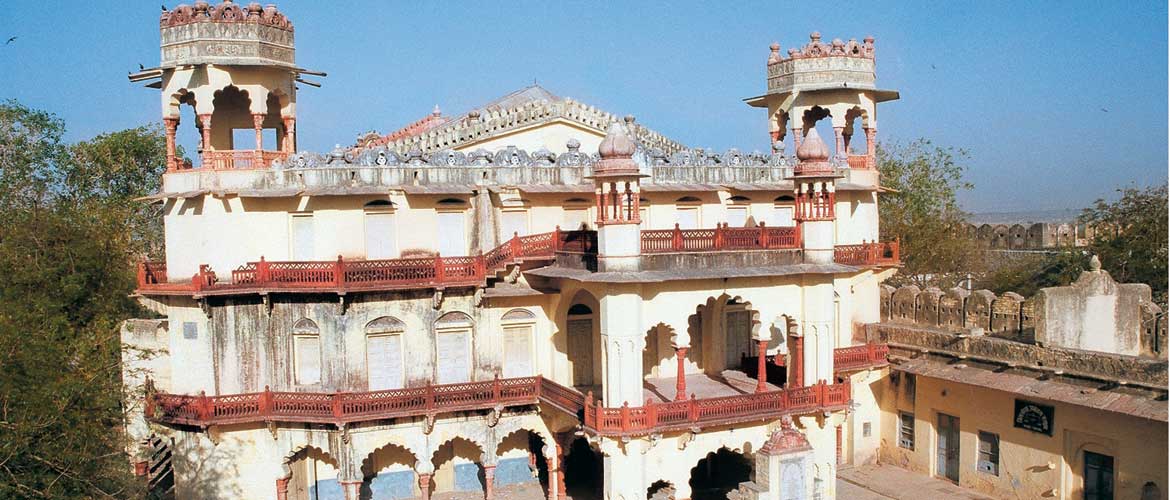Jhalawar usually stands to mean, the Jhalawar District which, along with Kota and Bundi, makes
THING TO SEE AND DO
The infrastructure of Jhalawar District hasn’t yet kept pace with the richness of its offerings. The town is small enough and to merely see the sights half a day is sufficient as well.
Garh Palace
The original residence of the royal family, the Garh Palace, as its name suggests, is a grandeur-defining citadel-palace. Built by Maharaj Madan Singh during 1840-45, it was later handed over to the government to house collectorate offices. You can walk through and see the Sheesh Mahal rooms partitioned into cubicles, splendid frescoes with electric fittings, and the inlay work on walls and ceilings covered by a layer of dust. A few lock ed rooms are repositories of every variety of artistic expression, from pietra dura to miniature styles to religious portrayal to portrait painting to English landscapes and floral studies to some rare glasswork.
TIP If you stay at the Prithvi Vilas Palace, you have a good chance of accessing closed rooms
Within the Garh Palace enclosure stands the Bhawani Natya Shala, an opera-house-style theatre made by Bhawani Singh, the king responsible for the creation of modern Jhalawar. Again, this is a faded structure, locked and forgotten. But this was once a vibrant centre for staging the works of Kalidas and Shakespeare; the proscenium is built with an underground extension, such that horses and chariots could appear on stage! At the Government Museum, just outside the Garh Palace, you can see abundant treasures of ancient Indian art, many dating back a millennium, some of them rescued from the jungles of Kakuni. It houses sacred sculptures, rare manuscripts, paintings, coins and interesting 5th and 7th-century inscriptions.
Palace Timings 9.00am-5.30pm, Closed Fri days Museum Entry ₹3; Mondays free Timings 10.00am-5.00pm

Rain Basera
Another of the royal family’s former residences, the Rain Basera makes for a lovely short foray from Jhalawar, made all the more lovely for its association with a king who would not rule. Maharaja Rajendra Singh had a dream of abdicating the kingdom for his son and retiring to write poetry. He saw this timber house in an exhibition in Lucknow in 1936 and had the whole edifice transported and installed at the vast Krishna Sagar Talab here. But – it does break your heart to think of it – he died soon after. It is today managed by the Irrigation Department.
Jhalrapatan
Zalim Singh, the founder of the Jhalawar kingdom, used to camp at Jhalawar but the place he lovingly nurtured from 1796 was Jhalrapatan, translated as ‘the City of Temple Bells’, locally called Patan. According to the chronicler James Tod, there are 108 temples here today. The riverside township overlaps the city of Chandravati, said to have been founded by Parmar Chandra Sen, Vikramaditya’s grandson. Today, Patan is a walled settlement you enter through a formal doorway and are immediately gifted with the combined stillness of three banyan trees, a huge pond and quaint chhatris under which villagers rest in the afternoon.
For some peace and quiet, you can always stroll or drive down to the site of the Chandramouli Mahadev Temple, cared for by the Archaeological Survey of India (ASI), situated in the beautifully maintained grounds next to the Chandrabhaga river. This complex holds the remains of many 7th-14th century shrines. While Jhalrapatan is dotted with old Jain and Hindu temples, the 11th-century Sun Temple is the pride of the town. Strictly speaking, it’s a temple of Padmanath, whose image was enshrined here in the 19th century. With its lofty 97-ft high shikhar and its association with the sun, the Jhalrapatan residents call it the ‘Konark of Rajasthan’. The shikhar is indeed impressive, teeming with small images of gods, goddesses, ganikas, apsaras, animals and, inevitably, some erotica.

WHERE TO STAY AND EAT
The few stay options in Jhalawar include a heritage property and a couple of bud get hotels. The Prithvi Vilas Palace (Tel: 07432-231347; Tariff: ₹8,000, with meals), in Civil Lines, is locally recognised as ‘Darbar ki Kothi’. They arrange guided tours on request. RTDC’s Hotel Gavdi Talab (Cell: 09414583445; Tariff: ₹1,700) has a restaurant, beer parlour and parking. Another RTDC property, Hotel Chandrawati (Cell: 09414391006; Tariff: ₹600-900), on Patan Road, has rooms with a TV and attached bathrooms, a restaurant and laundry service. Hotel Krishna Palace (Tel: 232324, Cell: 09414194473; W hotelkrishnapalace jhalawar.com; Tariff: ₹999-3,000) has facilities such as a restaurant, travel help, Internet, power backup, laundry and room service.
Meals are another good reason to stay at the Prithvi Vilas Palace. The cooks are efficient and there’s an interesting Gujarati flavour to the home-made food. The road between Jhalawar and Patan has roadside restaurants of which Rupali Dhani has a pleasant garden set ting. Try the red-hot sev ki subzi at the highway dhabas and the poha from local halwais in Patan.
When to go October to March is the most pleasant time to visit; Jhalawar can get hot in the summers and the roads can get very troublesome in and after the monsoons Location In southeast Rajasthan, at the edge of the Malwa Plateau Air Nearest airport: Jaipur Rail Nearest rail: Kota
Chandramouli Mahadev Temple
Garh Palace
heritage


